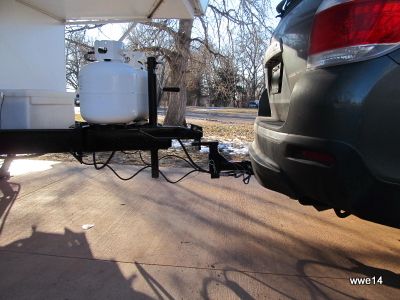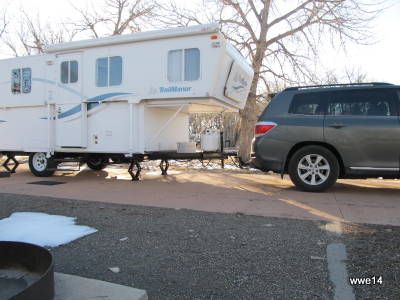 |
|
 03-03-2014, 09:25 PM
03-03-2014, 09:25 PM
|
#11
|
|
Site Sponsor
Join Date: Sep 2013
Posts: 31
|

Thanks for digging those up ELM. I didn't not know there were types of frames that would not do well with a WDH. Very interesting.
I should also note that we bought our TM from The Car Show in Colorado Springs. They installed the electric brake controller, they recommended the hitch height, they approved the balance and the way we towed out. I'd like to believe they know what they are doing, being a dedicated TM dealer.
Our TM has a sticker inside the cabinet under the sink listing an unloaded weight of 2673#. We do have the awning and AC, plus two batteries and loaded gas tanks. I believe those add about 500# or so. We don't live in our car so it was just the weight of 1/4 tank of gas and the weight of our family of five. Since we are slim and have young ones, that was a mere 250# sans driver. I've carefully planned and weighed everything that will go in the camper. It will come in well under 300#. Food for each weekend trip will be around 30#. Everyone is allowed one 18" duffle for the weekend and no electronics so that's only another 50# max there. There is no danger of exceeding the weight limit for our TV.
We're taking it out this weekend(and doing a lot of shivering I imagine)so I will take some pictures of our ball height so you can see. It looks alright to me but I really don't know much about this. :P We will also try towing in 4WD mode to see if distributing the drive to all the wheels makes a difference.
Thanks so much so far for all your help! Will check back in later to report.
|

|

|
 03-04-2014, 12:15 AM
03-04-2014, 12:15 AM
|
#12
|
|
TrailManor Master
Join Date: Oct 2011
Posts: 251
|
Lots of good advice here.
One other thing you could look at would be resonance. If the trailer and tow vehicle are configured in a manner that it "likes" to chug then that would explain it. If you want to get technical with it you can google up "resonant frequency" but you don't have to.
It's easy to test. Just adjust the height of the ball a little bit.
Another thing to check would be tongue weight. If it's too heavy then the unibody could be flexing a little. You could take it back to The Car Show and see what they think. They are a really good dealer and I'm sure they'll help you out.
__________________
Camping Sunny Southern California
2003 3124KS
2005 Tundra Double Cab
|

|

|
 03-04-2014, 09:15 AM
03-04-2014, 09:15 AM
|
#13
|
|
TrailManor Master
Join Date: Jan 2014
Location: Somerset, OH
Posts: 1,868
|

The post about a 1200 WDH for a 400 lb tongue. 1,200 is the tongue weight rating of that WDH. I know over the years that I have read with WDH if the rating of the bars is over rated for the application you can have more problem than not using a WDH. So I would not use 1200 lb bars with a 400 lb tongue load. The spring bars will not work right with such a small load. I have seen by reese, light tongue weights 350, 400 and 600 lbs wdh. So there are hitchs made for light tongue weights.
I not sure about a highlander, but my Toyota sienna lists in the manual (unibody). The manufacture rises the tongue weight capacity from 350 to 525 with the use of WDH. I don't think toyota would have rated it if they had a concern with the uniboady.
We just pick up a reese 600 WDH hich. Before ordering it I check with reese to make sure that it was sized correctly. They told me the hitch was good for tongue weights between 200 to 600 LBS. I would assume that a 1200 WDH is good for tongue weights between 800 and 1,200 lbs
I would check the manual for WDH information and only use a WDH that rated for the right application.
__________________
Art & Joyce
Current camper: Motor Home
Previous: 2009, 3023-QB and 2003 2720
|

|

|
 03-04-2014, 11:04 AM
03-04-2014, 11:04 AM
|
#14
|
|
TrailManor Master
Join Date: Oct 2012
Location: North San Diego County (Fallbrook)
Posts: 632
|
I think the confusion lies with the fact that there isn't a standardized formula for establishing tow ratings for vehicles. Each manufacturer uses their own formula and some of them stretch the limit of what a standardized formula would reveal. There has been a lot of discussion on passing a industry standard for tow ratings. I think that would be a good thing for all of us.
__________________
Tim
"A man creates his own legacy. Create a legendary life"
|

|

|
 03-04-2014, 11:22 AM
03-04-2014, 11:22 AM
|
#15
|
|
TrailManor Master
Join Date: Jan 2014
Location: Somerset, OH
Posts: 1,868
|
Some day all the manufactures will conform to The Society of Automotive Engineers tow standard, SAE J2807 standard, which they all agreed to comply in 2009 by 2013.
I think at this point Toyota is the only manufacture that have met the standard. Ford is saying by 2015 it will be there on their trucks.
http://rvingwithmarkpolk.com/2012/12...7-update-2013/
__________________
Art & Joyce
Current camper: Motor Home
Previous: 2009, 3023-QB and 2003 2720
|

|

|
 03-09-2014, 10:57 AM
03-09-2014, 10:57 AM
|
#16
|
|
TrailManor Master
Join Date: Aug 2007
Location: Williamsburg, VA
Posts: 668
|
 Towing with a Highlander
Towing with a Highlander
- A weight distributing hitch actually applies less weight on the tow vehicle mounting points than a standard hitch does (I have the calculations, if anyone is interested).
- All tow vehicles carry a tongue load better with a WDH than without. The WDH makes better use of available axle capacities.
- Almost everyone needs a Weight Distributing Hitch. A 400# trailer tongue weight without a WDH easily becomes a 700# rear axle weight and a 300# unloading of your front wheels. Many of us would exceed gross weight limits with 700 extra pounds on the rear axle in addition to other loads.
- Load up and go to the truck scale, get the real numbers, look at the gross axle weight ratings on your drivers' side door post and then you'll know exactly how you're doing. My own numbers on the truck scale are here: http://www.trailmanorowners.com/foru...ad.php?t=10652
- Everyone should calculate their tow capacity in accordance with their owners' manuals, drivers' side doorpost labels, and tire ratings.
- People can be careless about towing opinions without having applicable towing experience.
- Both unibodies and truck frames have rated hitch capacities, which depend upon on proper mounting points, not the kind of frame a vehicle has. Trailer hitches today are always bolted to manufacturer supplied hitch mounting points. Nobody should be drilling new holes in frames to mount trailer hitches anymore.
- The WDH bar ratings are based on what might be needed for maximum tongue weight distributions. Bigger numbers probably provide a little stiffer ride in the TV, but the worst loads on the hitch mounting points are substantially higher than loads applied by the bars.
__________________
2005 TrailManor 3023
2003 Toyota Highlander 220hp V6 FWD
Reese 1000# round bar Weight Distributing Hitch
Prodigy brake controller.
"It's not how fast you can go, it's how fast you can stop an RV that counts."
|

|

|
 03-09-2014, 07:21 PM
03-09-2014, 07:21 PM
|
#17
|
|
Site Sponsor
Join Date: Sep 2013
Posts: 31
|
Ok, we took the TM out this weekend, about 100 mile round trip. I noticed very little chugging this time. We were on different roads and the lighting was much better. I could easily see how small dips and changes in road texture were creating a triple wave feeling as each axle hit those spots. Maybe that's all
I was feeling. However, I promised hitch height pics so here they are:


I can see more research on the WDH is warranted. I'm not even close to understanding how they work and how it would help us. I'm trying really hard though. Thanks so much for trying to educate me about this stuff! I'm paying attention, honest. We don't want to tow stupid. 
|

|

|
 03-10-2014, 08:00 AM
03-10-2014, 08:00 AM
|
#18
|
|
TrailManor Master
Join Date: Oct 2010
Location: Big Bend area, Florida
Posts: 2,120
|
Wow! that is some lift to get the draw bar ball and TM tongue at the right height. That looks like a 6 inch rise. Your TV reciever must be low to the ground. Typical trailer tongues are in the 18 to 19 inch range when level to the ground. I think the e-trailer site has something on this and also WDH's.
__________________
Axis 24.1 E 450 chassis, 6 spd tranny. GVWR 14500# GVCWR 22000 # GW(scales) 12400 #
[SIGPIC][/SIGPIC]
mods: 2- 100 watt solar panels, on roof, 300 watts portable
“They who would give up essential Liberty, to purchase a little temporary Safety, deserve neither Liberty nor Safety.” Benjamin Franklin
|

|

|
 03-10-2014, 10:05 AM
03-10-2014, 10:05 AM
|
#19
|
|
Site Sponsor
Join Date: Sep 2013
Posts: 31
|
Quote:
Originally Posted by scrubjaysnest

Wow! that is some lift to get the draw bar ball and TM tongue at the right height. That looks like a 6 inch rise. Your TV reciever must be low to the ground. Typical trailer tongues are in the 18 to 19 inch range when level to the ground. I think the e-trailer site has something on this and also WDH's.
|
I think we're on the 5" mark. And we paid more to have our hitch put on at the Toyota dealership because they would remove and cut through the bumper, not install the mount under it. An under bumper installation would have called for another 6" or so rise on the mount.
So it looks alright to you as is?
|

|

|
 03-10-2014, 12:47 PM
03-10-2014, 12:47 PM
|
#20
|
|
Site Team
Join Date: Feb 2003
Location: The mountains of Scottsdale, AZ, and the beaches of Maine
Posts: 10,216
|
I wouldn't be pleased with what I see. So I have to ask again, when you put the hitch weight on the ball, how much does the tow vehicle squat? In other words, if you measure the height of the rear bumper above the ground at some convenient point near the center, then hitch up the loaded trailer, and measure the bumper height again at the same point, how much has the bumper dropped? If it is more than an inch or two, you need to do something about it.
At the same time you are measuring the rear bumper drop (squat), you might also measure the front bumper rise.
Bill
|

|

|
 |
|
|
Currently Active Users Viewing This Thread: 1 (0 members and 1 guests)
|
|
|
 Posting Rules
Posting Rules
|
You may not post new threads
You may not post replies
You may not post attachments
You may not edit your posts
HTML code is Off
|
|
|
|
 » Recent Threads
» Recent Threads |
|
|
|
|
|
|
|
|
|
|
|
|
|
|
|
|
|
|
|
|
|
|
|
|
|

